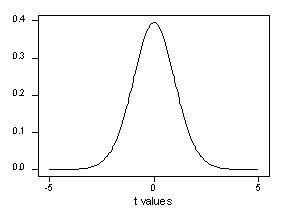Workshop Statistics: Discovery with Data, Second
Edition
Topic 20: Confidence Intervals II: Means
Activity 20-1: Christmas Shopping (cont.)
(a) quantitative
(b) In this case, $857 is a statistic, with symbol  ,
because it is the mean of a sample size of 922 people.
,
because it is the mean of a sample size of 922 people.
(c) The parameter of interest in this study is the mean amount expected
to be spent on Christmas presents in 1999 by all American adults, with
symbol m.
(d) No, but is more likely to be close to $857 than far from it.
(e) 250/sqrt(922) = $8.23
(f) 857 - 2(8.23), 857 + 2(8.23) = $840.54 - $873.46
(g) s, the standard deviation of the sample.
Activity 20-2: Parents' Ages (cont.)
(a)

(b) Shade middle 95% of sketch.
(c) .025
(d) t*=2.032
(e) t* is greater than z*
(f) 22.31 + 2.032(5.60/sqrt(35)) = (20.39, 24.24)
Note: Answers to (g)-(i) below are the answers
to (h)-(j) in the Calculator version.
(g) No, the distribution of ages at which the population of mothers
had their first child probably does not follow a normal distribution (evidence:
ages in sample are skewed to the right). Normality of the population
is not required for the use of this procedure to be valid. If the
population is not distributed normally, the procedure will be considered
valid as long as n > 30. In this case, n = 35.
(h) I'd be uncomfortable since the sample definitely has some skewness
and an outlier. We need the larger sample size for the central limit theorem
to kick in for the procedure to be valid.
(i) In the long-run, over many samples, 95% of the intervals generated
would contain the mean age at first of first child for all mothers in the
population.
Activity 20-3: Parents' Ages (cont.)
(a) Answers will vary from student to student.
(b) 22.52 + 1.96(4.89/sqrt(1199)) = (22.24, 22.80);
this interval is much narrower than the confidence interval from Activity
20-2.
(c) Answers will vary from student to student.
(d) 22.52 + 1.645(4.89/sqrt(1199)) = (22.29, 22.75); this interval
is narrower than the 95% confidence interval.
Activity 20-4: Sleeping Times
(a)
|
Sample number
|
Sample size
|
Sample mean
|
Sample std. dev.
|
|
3
|
30
|
6.6
|
.825
|
|
1
|
10
|
6.6
|
.825
|
|
2
|
10
|
6.6
|
1.597
|
|
4
|
30
|
6.6
|
1.597
|
(b) The sample means are equal.
(c) standard deviation
(d) sample size
(e) Sample 1 produces a more accurate estimate of m
because it has a smaller standard deviation.
(f) Sample 3 produces a more accurate estimate of m
because it has a larger sample size.
Activity 20-5: Sleeping Times (cont.)
Answers will vary from class to class.
